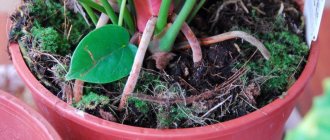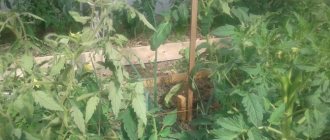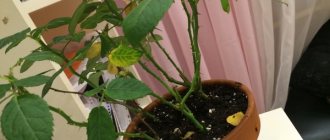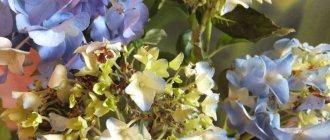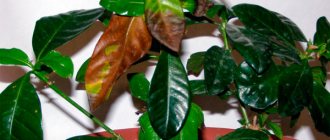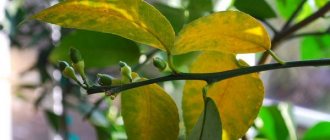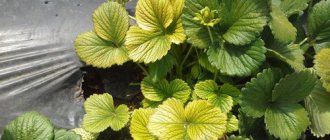Zamioculcas is an evergreen plant native to tropical Africa.
Dear readers!
For you, we have created communities on social networks in which useful articles and interesting ideas are published several times a day! Subscribe and receive useful content in a convenient format! This flower is popularly called the dollar tree. It is believed that if you plant zamioculcas at home, the owners will be guaranteed success in money.
The flower is not picky about its conditions and is easy to care for. But, like any other plant, zamioculcas can get sick or suffer from parasites. Among the most common problems are fungus, damage to the root system and yellowing of leaves.
Next, we will talk about why your zamioculcas got sick and how to help it.
Reasons related to leaving
The dollar tree is a hardy plant that can successfully resist many diseases and pests.
But sometimes the owner may notice how his pet’s leaves have begun to turn yellow. There are several reasons for this phenomenon.
First, let's look at the reasons related to flower care
Features of watering
Very often, dollar tree leaves turn yellow due to improper watering.
Zamioculcas does not like wet soil. In summer, the soil in the pot should dry out a little. It is also undesirable to have moisture in the pan. Therefore, if water has accumulated there after watering, it must be drained.
In spring and summer, the flower needs to be watered once every 7-10 days.
In winter, the dollar tree enters a dormant period. At this time of year it needs even less moisture. One watering per month will be enough.
Please note that you need to water the plant with water at room temperature. You should not use freshly drawn tap water for these purposes.
IMPORTANT!
If you are in doubt about whether to water Zamioculcas, it is better to wait 1-2 days. The flower will not dry out. It will be much worse if you “flood” it.
Wrong location of the flower
Location of Zamioculcas in the back of the room
Dollar Tree, being a native of Africa, loves bright light and warmth. Therefore, it is best to grow it on a south-facing window, and in summer take it out onto the balcony, veranda or yard.
But at the same time, the flower will not wither on the north side. It will just be a little smaller in size.
High humidity and low temperatures are very harmful for Zamioculcas. Such conditions of detention negatively affect the plant’s immunity.
Therefore, if the leaves of a flower begin to turn yellow, check its location. This is especially true for the cold season.
Drafts
It is highly undesirable to leave a dollar tree in a draft, especially in winter. If a warm summer breeze from an open window doesn’t do anything bad to the zamioculcas, then the winter draft causes the plant’s leaves to turn yellow and fall off. Dark spots appear on them. Young shoots are especially susceptible to this destructive process.
Sunburn
The dollar tree loves sunlight. But this does not mean that zamioculcas does not need to be protected from direct sunlight.
The plant can be exposed to the heat without harm only outside, where it is cooled by the movement of air masses. If you don’t take the flower out into the fresh air in the summer, then place it in the back of the room. This will protect your pet from harmful direct rays of the sun.
Prolonged exposure of the plant to the sun leads to burns, as the temperature of the leaves rises and cooling does not occur. As a result, they begin to turn yellow and then dry out completely.
Yellowing of zamioculcas leaves
Affected leaves need to be cut off at the root. But such pruning at the height of the season harms the appearance of Zamioculcas. The flower is slow-growing and is not able to restore green mass at a rapid pace.
If you do get burned, then you urgently need to rearrange the flower or shade the place where it is located. The leaves need to be treated with an adaptogen.
Frostbite
Zamioculcas leaves also turn yellow due to frostbite. This can happen, for example, if you ventilate a room in winter. And at the same time, the dollar tree stands under the open window. Or if in the fall a flower located in the open air was hit by the first frost.
In these cases, you need to remove the plant from the cold and treat the affected leaves.
Temperature changes
Zamioculcas withstands changes in ambient temperature. It feels good both at 12 degrees in winter and at 26 degrees in summer.
But keep in mind that the flower really does not like sudden changes in temperature. For example, if you decide to move the pot from the room to a cold balcony or corridor, the leaves of the plant will begin to turn yellow.
Therefore, to prevent your flower from suffering, provide it with a stable temperature regime.
Air humidity
The dollar tree is not picky about indoor air humidity and does not require spraying. But there is still no need to keep the plant in extreme conditions. And in too dry a climate, and with high humidity, the flower may feel unwell.
If the air in your apartment is too dry in winter, then wipe the leaves with a damp cloth. Sometimes you can spray the plant, but you shouldn’t overuse it.
IMPORTANT!
The most important rule for caring for zamioculcas is moderation. There is no need to arrange a survival quest for your green pet.
Improper care of the dollar tree
The most common cause of yellowing of zamioculcas foliage is excess moisture. The glossy, succulent leaves of this plant make you want to spray and water it all the time. And this needs to be done quite rarely. And instead of spraying, the dollar tree will prefer wiping the leaf blade with a damp cloth.
Why do hydrangea leaves turn yellow and the edges dry out - causes and treatment
Watering should be done only when the soil in the pot is completely dry. Firstly, Zamioculcas will not be able to absorb more moisture than it needs. And secondly, its roots extending from the tuber are tender and quickly rot. The rotting process causes yellow signals on the greenery. If the leaves have just begun to turn yellow, it is enough to adjust the watering. You need to loosen the soil in the pot and let it dry thoroughly. Let the plant stand in the drought for a while and only then water it.
It is worth paying attention to the volume of water for one irrigation.
Note! The moisture should reach the very bottom, but not linger in the pot. To do this, remove excess liquid from the pan and organize a good drainage system.
Frostbite and sunburn of succulent
Fleshy leaves are easily damaged by frost or direct sunlight. Frost marks become browner in color and look like spots on the leaf blade. The sun's rays leave rusty red spots. It is impossible to restore a yellowed sheet after this type of damage. It is important to prevent such damage to the foliage, since the process of photosynthesis and, accordingly, nutrition of the flower is disrupted.
Sunburn on leaves
Why is the dollar tree crying?
Good soil composition and moderate watering guarantee plant health. But when the volume of water for one watering is calculated incorrectly, and the drainage system does not remove excess liquid from the soil, the plant begins to “cry”. It looks like droplets of moisture on the leaves. This phenomenon is called guttation. This is how Zamioculcas removes excess liquid through special glands on the leaves - hydathodes. If this process is not responded to, the next step will be yellowing and wilting of entire branches of the plant. After discovering the “tears” of Zamioculcas, you need to stop watering it for 2-3 weeks and then moisten it with less water.
Note! Remaining moisture should be removed from the pan 30 minutes after watering.
Drops of water from guttation appear not only at the tips, but throughout the entire leaf blade
Natural aging
Another reason for yellowing of zamioculcas leaves is aging. It is easy to determine that yellowness appeared due to natural reasons. The dollar tree first gets rid of 2-3 yellowed leaves at the base of the branch. While at its end new leaf plates are formed. This is a natural process that indicates proper care of the plant.
You need to worry if the flower has slowed down its growth and does not want to renew its foliage. This indicates illness. This means we need to look for its cause.
Zamioculcas gets rid of old foliage
INTERESTING!
One cutting of Zamioculcas cannot have more than 17 leaves at the same time. Therefore, its old leaves periodically fall off. There is no need to be afraid of this if the plant looks healthy on the outside.
Natural yellowing of foliage
The slow growth of the dollar tree contributes to the gradual aging of the shoots. The twigs can remain on the flower for more than two years, and then only wither. And often the withering of such an old branch is regarded as a problem or disease. The dollar tree naturally turns yellow in no more than 5% of the total green mass. And only if this indicator is higher, you can start to worry.
You should also pay attention to the frequent shedding and yellowing of branches and begin to care for it more carefully. Typically, such a reset occurs during the plant's dormant period - in winter. But even in the active growth phase, the flower can shed old branches. In this case, it will not be superfluous to feed the plant. Fertilizer should be applied only in summer and in diluted form. The dollar tree is suitable for complex feeding for cacti.
It is very simple to determine the natural wilting of a stem - it occurs from the tip of the uppermost leaf and slowly goes down. You can recognize an old branch by the characteristic “wrinkles” at the base of the stem.
When Zamioculcas turns yellow, home care is the very first thing you need to pay attention to. After all, most often it is an excess of attention and excessive care that causes the yellowing and wilting of this plant. Do not forget about his African roots, because he is accustomed to drought and dry air.
Excess and lack of fertilizing
Like any living organism on the planet, zamioculcas needs proper and timely nutrition. A lack of nutrients leads to yellowing of the leaves, loss of appearance and general weakness of the plant.
The dollar tree accepts both organic and mineral fertilizers well. The ideal feeding scheme is to alternate types of fertilizer.
You can also do the fertilizing yourself. Professionals advise using sugar water, ground eggshells, yeast, citrus zest and banana peels as fertilizer.
The first time you need to feed a flower is when planting it in a pot. During the growing season, fertilizing should be done 2 times a month. When buds appear on the flower, feeding must be stopped until next spring.
Frequent fertilization is undesirable and can lead to plant disease.
Zamioculcas grows slowly, so excess feeding will only clog the soil and negatively affect the general condition of your pet.
IMPORTANT!
If you have “overfed” the plant, then you need to take the following measures:
- the flower must be removed from the pot;
- thoroughly clean from spoiled soil;
- check the roots of the plant;
- if there are damaged areas, remove them;
- transplant into another pot.
Dollar Tree Pests
If you care for your dollar tree according to all the requirements, and the plant continues to turn yellow, you should pay attention to the greenery. Or rather, the pests that can live there. Parasites suck the juice from the leaves and stems of the plant. This disrupts the most important process - photosynthesis, as a result of which greenery acquires its color. If photosynthesis is disrupted, the leaf blade becomes discolored, turning yellow, pale green or white.
Why do monstera leaves turn yellow - diseases and pests
Common dollar tree pests:
- scale insect;
- aphid;
- spider mite;
- thrips;
- mealybug.
All of them can cause yellowing of the foliage on the plant.
Note! But even before this, the sheet will begin to bend and curl. The main thing is to detect it in time, before the parasite population is too large.
The first thing to do is to rinse the green part of the plant under a warm shower (after closing the pot to prevent water from entering it). The second step will be treatment with a soap solution. After a few days, you can additionally disinfect the plant with a fungicide.
Aphids on the dollar tree cause its leaves to turn yellow
Recent transplant
Transplanting Zamioculcas
Like any plant, Zamioculcas needs to be replanted into a larger pot from time to time. At first, the flower will simply settle into a new place and spend all its energy developing roots to fill the entire space with them.
To ensure a successful transplant, be extremely careful and try not to damage the plant tubers. Any wound can lead to rotting and yellowing of the foliage. Therefore, after removing the plant from the old pot, you need to carefully examine its roots for wounds and cuts.
If you accidentally injured a flower, the wound should be treated with cinnamon or charcoal powder. After treatment, the tubers should be exposed to air for a while so that the wounds heal. The dollar tree can then be planted in a new pot.
What to do if zamioculcas leaves turn yellow
No measures need to be taken if the leaves of zamioculcas turn yellow from old age. As well as removing the drying plates entirely - rachis is still involved in photosynthesis. To make the flower beautiful, like in the photo, you can simply rotate it relative to the viewing point.
How to fix watering errors
If the zamioculcas is overdried, the earthen lump is taken out of the pot, if necessary, the roots are stripped, and immersed in warm water for a few minutes. Then dry it on newspaper and return it to the container. Water next time in about a month.
The advice to gradually moisten the earthen ball is only suitable for slight drying of the substrate, but such a maintenance error usually goes unnoticed. When the rachis or tubers have shriveled and the leaves have turned yellow, you need to save the zamioculcas and not splash the surface of the substrate with water. Such watering is not able to saturate the plant with moisture - immersion is necessary.
With slight waterlogging, when you can get by with drying the earthen clod on paper that absorbs water well, the leaves of Zamioculcas do not turn yellow. They change color if the sucking shoots or tuber begin to rot.
Algorithm of actions:
- Take the plant out of the container.
- Shake off the old substrate.
- Clean rotten areas of roots to healthy tissue.
- Disinfect wound surfaces.
- Dry in partial shade with good air ventilation and a temperature of at least 20° C for 1-3 days. Nothing will happen to Zamioculcas during this time. But what you can’t do is plant it in fresh soil right away - the leaves will continue to turn yellow, and perhaps the flower will die.
- The pot is washed, treated with potassium permanganate, and new drainage is added (at least 1/4 of the container).
- Plant zamioculcas in fresh cactus soil.
- Water for the first time after a month.
If the root has rotted completely, but healthy leaves remain, they can be rooted. Otherwise, elastic segments taken from the middle part of the rachis are planted in perlite or light soil.
Root problems and damage
Roots are the most important part of Zamioculcas. Root disease can lead not only to yellowing of the leaves, but also to the death of the plant.
There are 2 main problems:
- rotting of the root system;
- tuber damage.
If your pet's roots begin to rot, then with a high degree of probability you have “flooded” it. Excess moisture causes fungus to appear in the soil, which causes rot.
In this case, zamioculcas must be completely cleared of old wet soil, treated with a systemic fungicide, sprinkled with activated carbon or ash and replanted in dry soil. The soil must first be disinfected by pouring boiling water on it or placing it in the microwave for a couple of minutes.
The other most common problem with Zamioculcas roots is damage to the tuber. Most often this happens during transplantation.
If you do not notice the wound in time, it may become infected from the soil. If the infection begins to spread throughout the tubers, then only pruning the infected part can help. The cut area must then be treated with ash or activated carbon.
Zamioculcas root system
What to do to save the plant
Knowing why the leaves of zamioculcas turn yellow, you can determine a method for eliminating the problem.
- If watering is carried out incorrectly and the ground is too wet, it is necessary to remove the plant from the wet soil, remove excess soil that can be removed by hand, and then check the root system. If there is rot on the root, it is cut off and the sections are treated with a crushed tablet of activated carbon. After this, the crop is planted in new, dry soil.
If there is rot on the root, cut it off
- When a plant has suffered from an abundance of fertilizing, all that can be done is to replant it in new soil and just wait until it begins to recede. You should not apply new fertilizers until the plant has completely recovered and is growing again. Then, no earlier than 6 months later (if it is not winter), you can apply fertilizing.
Diseases and pests
There are two types of diseases that Zamioculcas can be susceptible to:
- fungal infections (fusarium, late blight, anthocrosis);
- bacterial infections (wet rot, dry rot).
The dollar tree is rarely attacked by pests because its leaves are covered with a protective waxy coating.
Only scale insects, spider mites, aphids and mealybugs can cause real harm to the plant. It is these parasites that are able to overcome the protective layer of the flower.
If you notice pests, you need to take the following measures:
- isolate the diseased plant;
- cover the soil with foil;
- collect parasites with your hands;
- wrap the flower in alcohol-soaked cloth;
- treat the affected areas with soap or tobacco solution;
- wash the leaves with clean water;
- treat with insecticides.
How to cure a plant?
To prevent fungal diseases on your exotic pet, it is recommended to follow certain rules:
- When replanting, carefully check for hollow holes in the ground. To prevent them from forming, when planting, shake the plant slightly so that the earth settles and fills all the formed cavities.
- After watering, when excess liquid seeps into the pan, it is recommended to drain it. If you leave water, the soil will continue to become saturated and, as a result, provoke the development of pathogenic bacteria.
- To get rid of acquired rot, you should cut off the areas with the greatest formation of dying tissue from the rotting stem. The procedure should be carried out until the tissue is completely healthy. After this, you need to treat the affected areas with the chemical insecticide Maxim. In addition, you can use disinfection in the form of a weak solution of potassium permanganate.
- When a tuber rots, it is recommended to transplant it from contaminated soil to fresh soil rich in nutrients. In this case, you need to cut off all damaged parts from the root system and treat with crushed activated carbon.
- If the stem and root system cannot be healed, then it is necessary to cut off healthy areas that have not yet been affected by the disease and root them in fresh soil. Only in this case will it be possible to save a rare specimen.
Thus, in order to prevent the spread of the disease, the general condition of the bush should be monitored. Immediately upon detection of yellowing of foliage, take preventive and disinfection measures.
Answers to frequently asked questions
Zamioculcas
Why does the plant rarely produce new foxes?
Zamioculcas is a slow growing plant. In addition, it takes a lot of energy to bloom.
Is it true that the dollar tree is poisonous?
Zamioculcas does contain some toxic substances. But they do not bring harm to humans. Moreover, the flower purifies the air in the apartment.
But we still do not recommend eating zamioculcas.
What does Zamioculcas need to grow?
Like any plant, zamioculcas first develops its roots and only then begins to grow. If your flower is not growing, you may have chosen the wrong size pot for it.
Also, keep in mind that active plant growth begins in the second half of summer and continues until early March.
How to propagate a dollar tree?
Zamioculcas can be propagated in any way: by dividing tubers, leaves, stems.
How soon will the transplanted plant produce its first shoots?
It is difficult to say exactly, since many factors need to be taken into account. The speed of germination depends on the volume of the pot, the time of year and the quality of the seedlings.
Causes of yellowing of leaves in Zamioculcas - treatment instructions
Zamioculcas or dollar tree is not considered a new plant on the windowsills of city apartments. Professional flower growers have been familiar with it for decades. But for beginners, growing African exotics raises concerns. And yet, they try to place a succulent bush in the house. After all, according to many beliefs, it brings happiness and financial well-being. But often it is removed from the house as soon as the first signs of illness are seen: only a healthy culture brings beneficial energy. Despite this, true flower growers are trying to determine why the leaves of Zamioculcas turn yellow and what to do about the manifestation of “capriciousness”.
Harmful insects
If no mistakes were made in caring for the plant, but the leaves still turn yellow, you need to carefully inspect it for the presence of pests.
The flower can be affected by red spider mites and scale insects. The mite settles on the back of the leaves, entwining them with a thin web . This is a very small pest, which, however, can cause big trouble.
You cannot kill a tick by wiping the leaves and rinsing with water. Harmful insects still remain and continue to multiply. And this ultimately ends in the death of the plant.
Insecticidal preparations are used against ticks, which completely destroy the pests.
Adult specimens of scale insects appear as small spots on leaves and stems . The pest sucks out the sap of the plant, causing the leaves to turn yellow. Scale insects are destroyed with special preparations that kill the larvae. Adult insects must be collected and destroyed.
Tips for growing Zamioculcas
The recommendations below will solve the problem of yellowing leaves and help the crop recover faster.
- When processing root sections, you can add a little root formation stimulator to activated carbon.
- If the leaves gradually turn yellow and then become colorless altogether, this means that the plant is not getting enough light or nutrition. You need to move it to another window, maybe this will help. But if it doesn’t help, you will need to fertilize.
- If the gardener is afraid to use mineral fertilizers, you can make fertilizer for zamioculcas from humus, eggshells or fresh herbs. Infusions of these products are nutritious and no less useful than minerals. You just need to use them in low concentration!
Zamioculcas is a beautiful crop. If you care for it properly, it will never bring any special problems, but will only attract good luck and financial well-being to the family. If the plant begins to turn yellow, you should not be upset in advance, you need to think about what the reasons might be, solve them, and then the culture will recover very quickly.
Dry air and dry soil
Severe drying out of the soil can also negatively affect the appearance of the plant.
If a lump of earth regularly dries out, it lacks moisture. In this case, its leaves begin to turn yellow, and some of the roots die. How to revive zamioculcas - you need to increase watering . To restore the root system, you can use special rooting preparations.
Yellowing can also be caused by very dry air and high temperatures in the apartment. In the summer heat, to prevent the leaves from turning yellow and drying out, you need to humidify the air in the room where the zamioculcas is located. Spraying with water or wiping the leaves with a damp sponge gives good results.
Why do leaves and stems dry out?
The decorative appearance of a houseplant is affected not only by overwatering, but also by a lack of liquid.
When there is a lack of water, the leaves and stems lighten, dry, curl and turn yellow due to the succulent saving resources and redirecting the maintenance of the root system in drought conditions.
Fall is observed over the entire area of the leaf mass. There is no point in throwing away a dried home flower; its roots can still be saved.
Necessary measures:
- at the first sign, if the leaves of a flower crop have dried, water it, but not with a large amount of water, but slightly moistening the soil;
- after 5-6 hours, watering is repeated and carried out a third time after a similar time period;
- restore the watering regime, starting after resuscitation with the next moistening, according to the general rules - when the substrate dries completely.
